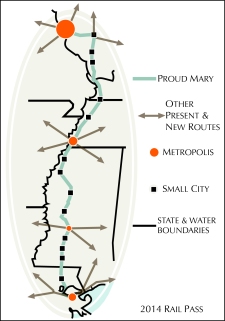Well, maybe not end them, per se.
The Sunset Limited is one of Amtrak’s coolest routes, but it’s one of the most disappointing as well. Running from L.A. to NOLA, it runs through some of the fastest-growing cities in the nation. You wouldn’t know it, though; the SL only carried about 100,000 passengers in FY 2013. This means that the route has the dubious distinction of being Amtrak’s fourth-longest, at nearly 2,000 miles, AND having the fourth-lowest ridership. It loses ten of millions of dollars per year, in spite of (or perhaps due to) the fact that it only runs in each direction only three times a week.
I’m also focused on the Crescent, which runs from NYC to NOLA. While it boasts three times the ridership of the SL over about 650 less miles, its still only carries barely over two hundred people per passenger mile. The problem is, of course, that the routes are just too damned long, which makes the trains arrive and leave major cities like Atlanta and San Antonio at horrible times.

From two to four: this map uses color to show how the Sunset Limited and the Crescent could become four routes of approximately 700 miles. Los Angeles, El Paso, Houston, Atlanta, and New York are the connection points. The maps have been oriented to suggest a somewhat straight line.
Both the Sunset Limited and the Crescent need to go into retirement. In their place, I propose creating four interlinked long-distance lines, each around the magical 700-mile length that makes Congress consider them part of the national network. Each of these lines can be broken into two pieces (making eight interlinked lines) that would fit the Brookings recommended 400 mile-limit, should Congress change its funding structure or the routes profit in the future. Here are the four, from L.A to New York:

Los Angeles – El Paso, with service to Palm Springs, Phoenix, Tucson, and places in between. I feel like there is a good song about desert or Arizona or something, but for now I’m going for the Desert Sunrise. Later, Phoenix could become a splitting point to create two lines, making L.A. – Phoenix and Phoenix – El Paso.

El Paso – Houston, with Service to San Antonio and three small cities in between, possibly with a continuation to Galveston. I thought about calling this the Yellow Rose in reference to the popular song, but I have since learned it had racist origins. So instead, I’m referencing Houston’s most famous resident–not Sam, silly. The Houston Rocket, a la Beyonce.

Houston – Atlanta, with service to New Orleans, Birmingham, and places between. There are a ton of name options here, and I can’t make up my mind. The Johnny B. Goode? The Sweet Home Express? For the former, I can just picture a retro ad campaign: “Go, Johnny Go! Go!”

Atlanta – New York, with service to Raleigh, D.C., Baltimore, Philadelphia, and cities in between.. This route would be popular, and once again we have plenty of naming option. Something to do with the Big Apple and the Georgia Peach… Tutti Frutti? It means “all fruits” in Italian, but it’s probably too ridiculous. What about the Big Peach?

